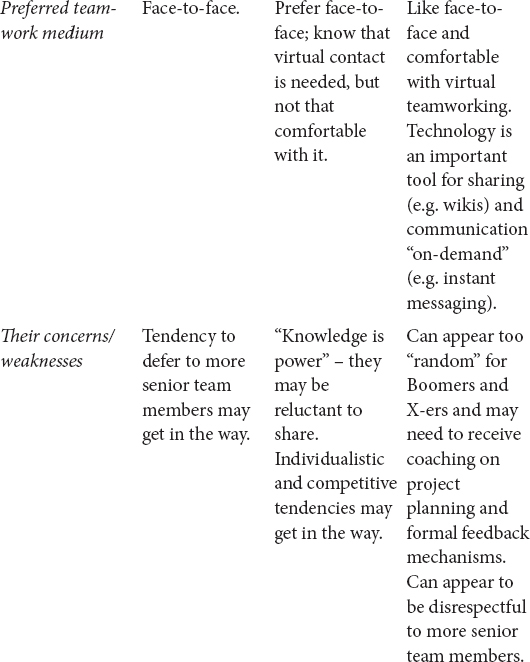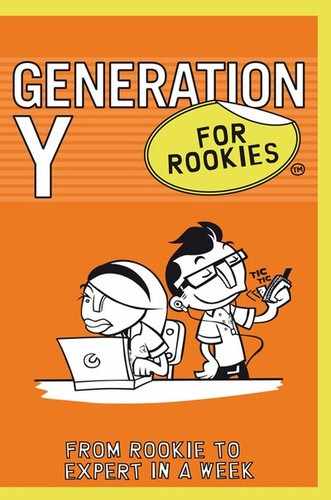CHAPTER 8
How do you build
effective cross-generational
teams?
What cross-generational teams can do
Innovation relies on a number of different and divergent perspectives being brought to bear on a problem. A mixed-generation team inevitably contains a diversity of perspectives and views which, if channelled well, leads to the best solutions, the best products and a highly engaged team.
Get it wrong, and it can mean conflict, ineffective working and a feeling of frustration for the team members.
Get it right, and you can release knowledge, wisdom and talent from all generations. A great cross-generational team feels vibrant, and there is a sense of learning and fun within and between the generations.
 Rookie Buster
Rookie Buster
A great cross-generational team feels vibrant, and there is a sense of learning and fun within and between the generations.
Before we go any further on the subject of cross-generational teams, let’s just pause for a minute and look at what we mean by teams. Essentially, for this purpose there are three types of team:
1. Those whose team is the organization or department/group they work in. These can obviously be large teams with a common overall purpose but little day-to-day contact or experience of working together.
2. The smaller groups that people work in and with which they share some specific common goals – for example, an HR department.
3. The project team – that is, a group of people who have come together for a particular period of time to achieve a specific goal.
Clearly in today’s world that is not an entirely accurate representation of the concept of teams. People who haven’t met can collaborate online to develop open source technology, for example. Loose networks of people can communicate and sometimes work together towards a common purpose. Work boundaries are becoming increasingly blurred. The purpose of this chapter is not to try and address all possible definitions and configurations of the term “team”, but to help you to understand the ways in which different generations work together, and how to help them to work productively across generation boundaries.
Inevitably most teams today are made up of two or more different generations, so understanding how to have them work really well together is important. This chapter will give you the insight and practical guidance you need to build excellent and productive cross-generational teams.
How do the different generations
work in teams?
Each generation has a different style of working in a team. Let’s take a look at the different team styles and preferences of the different generations. It is important for everyone to understand these if they are to work together in a productive way, not in order to stereotype the different generations, but in order to understand where they are coming from and how they work together in teams.


What are Gen Y like as team
members?
The characteristics and behaviour of Gen Y in a team can bring huge benefits as well as conflict. Let’s take a look at the Gen Y characteristics, with specific reference to teamwork. It depends upon your perspective as to whether you judge these characteristics to be helpful or unhelpful in a team environment. To a large extent it depends upon what kind of culture you want to foster.
This list is not meant to be an exhaustive list of Gen Y’s preferences and behaviours. It is meant to help you to understand the contribution Gen Y can make in a team and the possible implications of their team behaviour.
Gen Y characteristics |
Implications |
More likely to speak up, challenge and ask the uncomfortable questions. |
Very useful in terms of pursuing the goals of the team, but may be very uncomfortable for others and can cause conflict. |
Not deferential to authority and see all team members as “equal”. They talk to “people” not “positions”. |
Again, can be uncomfortable for other people in the team, but it leads to much better quality conversations and ultimately better outcomes. |
They respond to mentoring, not being told what to do. |
This is great if the team develops a culture of co-mentoring. Can cause problems if team members step into an unhelpful “command and control” mode. |
They are natural networkers and will involve people outside the team (and sometimes outside the organization). |
This is clearly helpful in terms of bringing to bear a range or ideas and resources. The downside is that some members of the team may feel protective of the team and unwilling to loosen the boundaries of the team “wall”. |
Naturally optimistic and can come across as very confident. |
These characteristics are on the whole very positive. However if optimism is overdone it can turn into lack of realistic expectations – and it can look like arrogance and annoy other team members. |
They tend to multitask and organize their work in less of an obviously “planned” way than the other generations do. |
Multi-tasking can be good when it means a person is being fast and efficient. The Gen Y preferred way of working can seem chaotic to others. The key is to focus on the outcomes, not the process. |
They set great store by trust and good relationships in a team. |
This may be seen by some as focusing on the relationships at the expense of the task in hand. But of course both are important. |
They gravitate to doing only the work that they are particularly interested in and that gives them a buzz. |
This is fine as long as all team members are able to choose the roles and tasks that they are interested in too. And if all team members’ interests are being met it will make for a high-performing and energetic team. |
You may be thinking that making teams of different generations work together is a nightmare. Well, it can be if you don’t understand how each generation is different, and the simple steps you need to take to make the team work.
Also, and importantly – you need to be convinced it’s worth it. So here are the benefits.
What are the benefits of effective
cross-generational teams?
Most organizations today are, by definition, multi-generational groups of people. It follows therefore that most organizations would benefit from understanding how to get the most from their entire workforce and helping them to work productively together.
As with any diverse group of people working together, different generations working together can bring huge benefits to the individual, the group and the organization. The benefits listed below are as applicable to large teams (entire organizations) as they are to small project teams.
The specific benefits of effective cross-generational teams include:
• Increased insight into different customer age segments. Bringing a range of perspectives to bear on an issue is clearly important when working on issues that affect your customers and individual consumers, as it means that you are taking account of a range of ages/generations.
• Improved knowledge sharing and knowledge management. Organizations often struggle with how to capture and share the immense knowledge of the senior people in an organization. Mentoring is one way of doing this, as is good cross-generational team working. The informal networking aspects of a dynamic team are also a fantastic medium for surfacing the knowledge and wisdom of its members.
• Breaking down hierarchical and status barriers. These barriers can be unhelpful when they inhibit open conversations, sharing and healthy challenge. The more the different generations can understand about one another and work together, the more the barriers will be broken down.
• Better solutions. When people with diverse views and perspectives work together, provided they learn to listen to and work with this diversity, they inevitably produce better solutions and products than homogeneous teams can produce.
When setting up project teams, before getting stuck into the task in hand, spend time getting them to look at the benefits of working together and bringing different views and perspectives to bear. This signals that it is fine – in fact, desirable – to have different views and to disagree at times.
 Rookie Buster
Rookie Buster
It is fine – in fact, desirable – to have different views and to disagree at times.
So, on to the nitty gritty – how do you make a team work when you have a whole load of different preferences, characteristics and opinions, not to mention personality types, involved?
I’m not saying it’s easy, but it is a whole lot easier than some people think. Follow these steps and you will be in good shape.
Seven steps to great teamwork
Step 1. Spend some time with the whole team exploring their generational and style preferences
Obviously if the whole team is a large group of people it is most effective to do this work in people’s immediate work groups or project teams. Team leaders often introduce the use of personality preference tools, such at the Myers-Briggs Type Indicator questionnaire. Most people don’t think to look at generational differences, but this is an area that organizations who really understand the value of diversity (of ideas, thoughts and perspectives) pay attention to. Use the table on pages 113–14 to start a discussion on differences and the benefits and disadvantages of different behaviours in a team. By having these discussions up front you create an atmosphere and a language for people to use when the going gets tough and disagreements occur.
It’s important to say here that disagreement within teams is not a bad thing. It can on the contrary be a good thing, if it gives the team a chance to work on and resolve their differences, leading to more productive relationships and outcomes. However, if conflict is not managed well it can cause lasting damage to the team.
 Rookie Buster
Rookie Buster
Disagreement within teams is not a bad thing. It can on the contrary be a good thing, if it gives the team a chance to work on and resolve their differences.
Step 2. Make sure the team’s purpose is clear
It’s not just Gen Y who like to understand the big picture and their part in it. When the team first forms (and when new members join), spend time exploring, agreeing and clarifying the purpose of the team and everyone’s part in it. Make sure that new employees’ induction includes spending time looking at the organization’s and team’s purposes as well as their own purpose.
Step 3. Allow time for relationships to gel and trust to build
This cannot be forced, but it can be facilitated. Spending time exploring people’s preferences (Step 1) will help get this process kick-started. And build in plenty of time for the team to spend with each other on both work and non-work activities. As and when issues come up that threaten to damage trust in the team (like when a conflict arises), see it as an opportunity to deepen the trust rather than allowing it to damage relationships. Examining trust in teams is a whole book in itself, but essentially if you encourage the team to speak openly to each other and to air disagreements, this will build trust. If views and opinions are suppressed it will only result in team members “leaving the team” emotionally and/or encourage factions to develop.

 Rookie Buster
Rookie Buster
If you encourage the team to speak openly to each other and to air disagreements, this will build trust.
Step 4. Allow time to review how the team is doing
Many teams get so into the task in hand that they don’t give any time or attention to the individuals, relationships or team dynamics. This doesn’t have to be onerous. It can be as simple as having a short “check in” and “check out” at the beginning and end of team meetings and asking people the following questions:
• What is it like working in this team – what is working well and/or do any changes need to be made?
• As a team are we using each person’s preferences to positive advantage or are the different preferences causing conflict?
Give each person a couple of minutes to answer each question and appoint someone as a facilitator of the session so that you stick to time and stay on the point. If any problems or concerns come up, give them airtime – this may feel to some like wasting time, but if you don’t resolve any issues as quickly as possible they will waste a lot more in the long run.
Step 5. Don’t focus exclusively on the task
A great team pays attention to the individuals in the team, their relationships and their levels of engagement. Regular quick reviews will allow airtime for all the non-task aspects of excellent teams. This process will build trust, improve communications and allow people to get to know one another and develop a great team spirit. Gen Y are used to collaborating and have grown up with the notion of communities. This is natural territory for them, and they will be much more engaged if due attention is given to all aspects of the team, not just the task in hand.
Step 6. Help them to learn
Efficiency and innovation only happen if people keep on learning. Gen Y is very hungry to learn and will expect to receive feedback, and will also expect others in the team to want to hear feedback from them. It is important to create an atmosphere in which this is welcomed. For most people, learning doesn’t just magically happen: they need to be given the time and space to reflect, to be asked good questions and to be given quality feedback. This shouldn’t be a weighty process. It’s a five-minute “Hey, John, have you got a minute to review how that client meeting went so we can improve and build on it next time?” This approach will build a culture in which people question and give feedback with the intention of learning, growing and improving. Having at least a few role models – people who are skilled coaches and mentors – in the team is invaluable. If you haven’t already got them, find a few people who are naturally talented and interested coaches and ask them to facilitate learning in the team whenever they have a chance.
 Rookie Buster
Rookie Buster
Gen Y is very hungry to learn and will expect to receive feedback, and will also expect others in the team to want to hear feedback from them.
Step 7. Talk honestly about failures and celebrate successes
Open and honest communication in a team is crucial. People need to feel as though they can speak up. Gen Y are naturally inclined to do that anyway, so may be a good role model. Honest talking means being able to raise anything, good or bad, with the greater good of the team in mind. Celebrating successes is really important too. We all like the feeling of a job well done, and recognition, in its many forms, is important to most people. Celebrate success when it occurs, and recognize the contributions of everyone.
All of the seven steps are of course valid for any team. Teams that are made up of different generations (as well as different personality types) have a great possibility for success because of the diversity they bring, but they also have a great possibility for conflict for that same reason.
In a world that is changing so fast, the ability to engage people’s talents to the maximum is what sets the great organizations apart from the mediocre ones. Creating excellent teamwork should be a priority, because not doing so will certainly damage your ability to create the ideas, products, services and relationships that all organizations need in order to be truly successful.
Great teamwork is a crucial source of competitive advantage. If you are not sure how to go about it, or think you could be doing better, bring in a coach or someone who can help you to do it. Your goal should be to develop a strong in-house capability in teamwork.
 Rookie Buster
Rookie Buster
Great teamwork is a crucial source of competitive advantage.
Coach’s notes 
1. Run short workshops to show team members how to explore different generational and personality preferences and appreciate the value (and potential conflict) that comes from these differences.
2. Train managers and leaders to understand, manage and engage cross-generational teams.
3. Make sure that you have some team members (including the team leader) who have a passion for mentoring and coaching, and the skills to do it well. Ongoing learning is essential to productive teams, and coaches and mentors help people learn.
4. Use the seven steps to great teamwork, and encourage dialogue with the team about what great teams do.
5. Ask the team how they want to change or improve the way they work – make them responsible, but give them guidance and training to enable them to live up to the responsibility.
6. Encourage all team members to be responsible for effective teamwork. Do this not by “imposing” rules, but by discussing, training, coaching and, most importantly, encouraging two-way communication.
Go for it! Each generation has its own knowledge and wisdom. It is not true that older people are always the wiser ones, and that it is for them to teach the younger generations. All the generations can learn from each other. Each brings its own perspectives, wisdom, skills and gifts to a team.
If you create an atmosphere in which everyone plays to their strengths and rich cross-generational diversity is valued, you will have not only a vibrant, dynamic team, but also a competitive advantage.

Notes |

